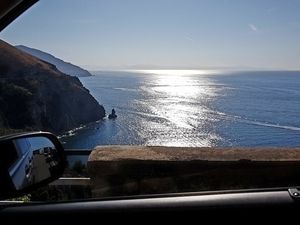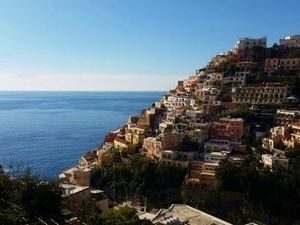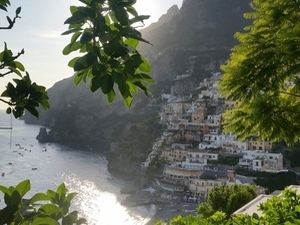On one of the most beautiful stretches of coastline in the Province of Salerno, at the centre of the gulf formed by point Germano to the west and cape Sottile to the east, on two mountain slopes, those of Mounts Comune and S. Angelo at Tre Pizzi, stands Positano
Its territory preserves traces of very ancient settlement, already evident in the Palaeolithic period, as testified by remains found in the grotto named La Porta, not far from the town, but also Roman remains, such as those of a large villa, visible close to the parish church. According to tradition Positano was founded by inhabitants of nearby Paestum, refugees after a Saracen siege, on the spot where a Benedictine abbey dedicated to St. Vito already stood before the tenth century. Its praises sung by illustrious poets and writers and immortalised by painters from all over the world, nowadays Positano is one of the most interesting places on the Amalfi coast. The centre of the town is enchanting: here in small Flavio Gioia square, among the delightful white or pastel-coloured houses, with their typical cubic shape and the greenery of luxuriant gardens, stands the parish church of Santa Maria Assunta, with its splendid majolica dome. Considered one of the best-equipped and exclusive tourist resorts in Italy, also famed for its flourishing fashion tailors, Positano perfectly combines the beauty of its natural surroundings and numerous beaches, Marina Grande, Ciumicello, La Porta, Arienzo e Fornillo, with the fascination of its ancient fishing port and the charm of its steps and lanes crowded with quaint colourful shops.
Quality fashion tailoring is an activity that has distinguished Positano since the end of the 50's when, with the creation of the bikini, innovative swimming costume, the town on the Amalfi coast became famous in Italy and throughout the world. Nowadays production is wide ranging and offers a great variety of clothing: including typical garments for the seaside, wraparound skirts, beach robes, bags and Bermudas, to the more formal afternoon clothes or elegant evening dress and even very special wedding dresses. Bright, cheerful patterns, brilliant colours and the use of absolutely natural materials, linen, gauze or cotton, characterise Positano fashion. After a phase in the 1950s and 60's, in which Hawaiian-inspired designs predominated, during the 70's plain-coloured gauze took over, instead today, patterns that portray Mediterranean plants prevail, lemons, flowers and leaves, "borrowed" from the luxuriant natural surroundings. So, pleasant little shops cheer the lanes of the centre and are a must for the many tourists who come to the town all the year round. Apart from its skilled tailors, Positano is outstanding for its famous cobblers, able to create the typical Positano sandals hand-made to measure while you wait in front of the shop: with names like "spider", "monk", flipflops, wooden or cork clogs and the very comfortable canvas mules, with string soles.
Right in the centre of Positano, in the small Piazza Flavio Gioia, stands the parish church of Santa Maria Assunta. The building with its large majolica-mosaic dome, contains important works of art, outstanding among which is a Circumcision, a stupendous work by Fabrizio Santafede, from the end of the sixteenth century, and a delightful thirteenth-century Byzantine-style panel depicting the Virgin and Child. According to popular tradition, the origin of the town's name is linked to this very icon: looted by the Saracens, the precious panel was brought back to land following a storm, while from the shore was heard the prodigious cry "posa, posa" (put it here). Having given back the ill-gotten icon, the sea calmed down, so a church was built in honour of the Virgin on that spot and the town grew around it, that took the name of Positano. The bell tower is also very interesting with a medieval bas-relief portraying a sea monster, some fish and a fox, probably to underline the dual nature of the coastal inhabitants' souls, half countrymen and half seamen.
Positano cookery offers a series of tasty specialities, some linked to typical seafood traditions, others to country cookery. So, both delicious fresh fish- and meat-based dishes are available. Among the most typical recipes should be mentioned the tasty spaghetti with clams, dressed only with olive oil, naturally locally produced and extra-virgin, and parsley, without tomatoes, the delicious fish soup, appetising fried anchovies, dressed with mint, vinegar and garlic, the delicate swordfish roulades, stewed octopus cooked in earthenware with tomatoes from S.Marzano, or boiled or indeed raw, freshly fished, and mussels in black pepper. For those who prefer meat, the rich grills over charcoal are recommended, a typical dish of the area, accompanied by exquisite vegetables, prepared in a great variety of ways. The dairy products are delicious, especially the mozzarella cheeses, to be enjoyed as they are or roasted on lemon leaves, to a local recipe. Moreover, Positano is well-known, like the other towns along the coast, for its long tradition of confectionery: among the dainties should be mentioned the lemon delights, that are outstanding hereabouts for their excellent quality and extraordinary sweetness, and the Positano cake, the "babarese", a rolled baba pastry filled with cream and wild strawberries, and the original puff pastry without ricotta. All washed down with excellent liqueurs, prepared to ancient recipes, based on the aromatic local citrus fruits, or wild strawberries, wild bilberries, roses, laurel, prickly pears, fennel and walnuts.





